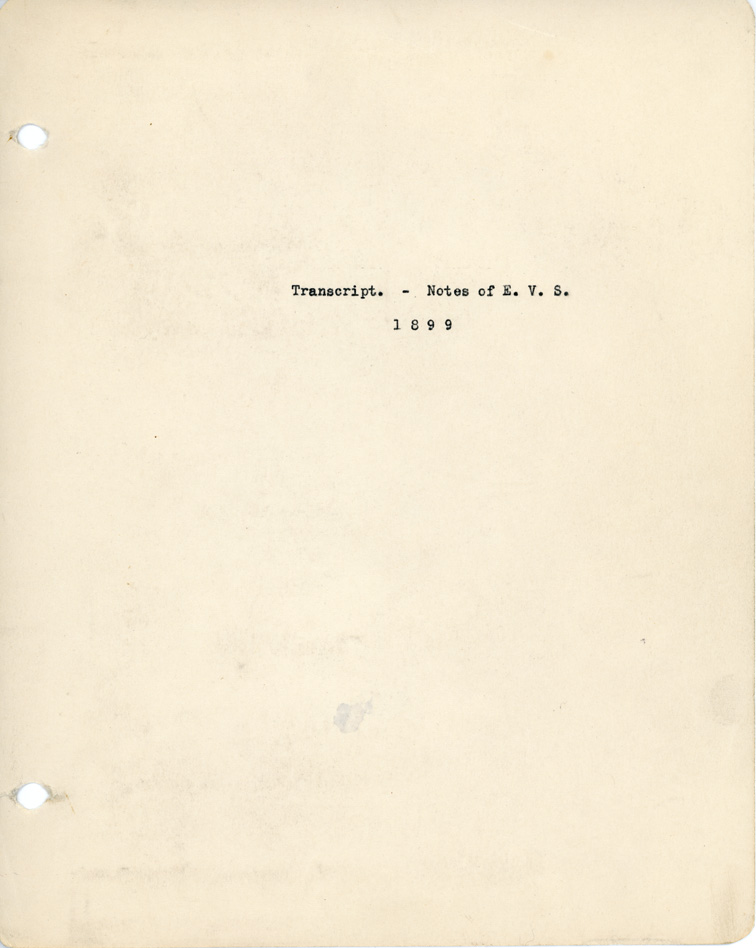Great Nebraska
Naturalists and Scientists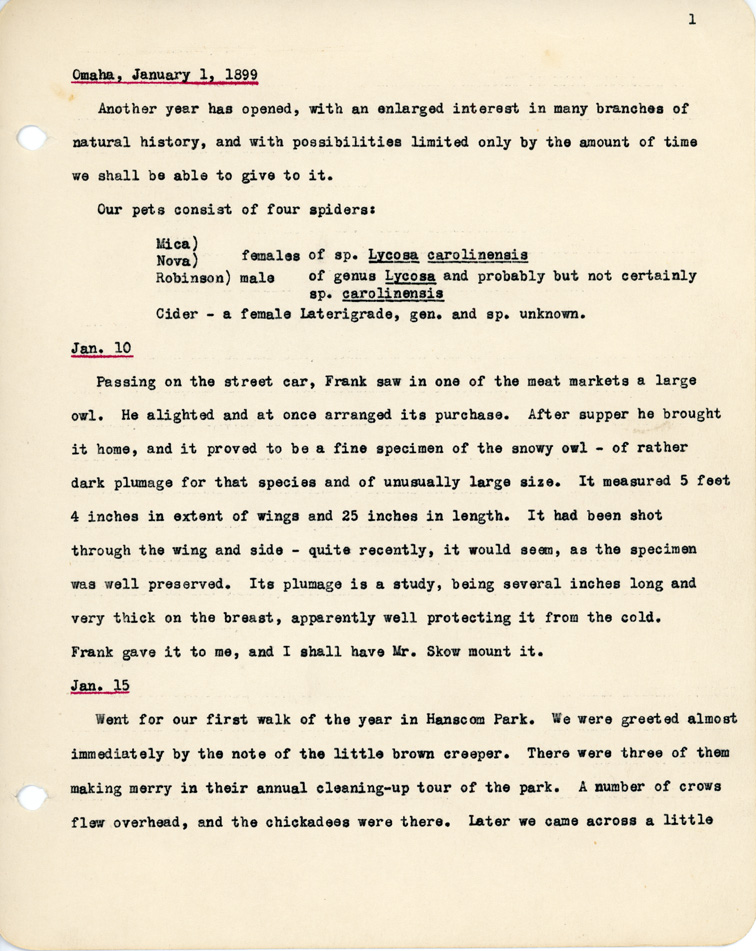
Omaha, January 1, 1899
Another year has opened, with an enlarged interest in many branches of natural history, and with possibilities limited only by the amount of time we shall be able to give to it.
Our pets consist of four spiders:
Mica)
Nova) females of sp. Lycosa carolinensis
Robinson) male of genus Lycosa and probably but not certainly sp. carolinensis
Cider – a female Laterigrade, gen. and sp. unknown.
Jan. 10
Passing on the street car, Frank aw in one of the meat markets a large owl. He alighted and at once arranged its purchase. He slighted and at once arranged its purchase. After super he brought it home, and it proved to be a fine specimen of the snowy owl – of rather dark plumage for that species and of unusually large size. It measured 5 feet 4 inches in extent of wings and 25 inches in length. It had been shot through the wing and side – quite recently, it would seem, as the specimen was well preserved. Its plumage is a study, being several inches long and very thick on the breast, apparently well protecting it from the cold. Frank gave it to me, and I shall have Mr. Skow mount it.
Jan. 15
Went for our first walk of the year in Hanscom Park. We were greeted almost immediately by the note of the little brown creeper. There were three of them making merry in their annual cleaning-up tour of the park. A number of crows flew overhead, and the chickadee were there. Later we came across a little
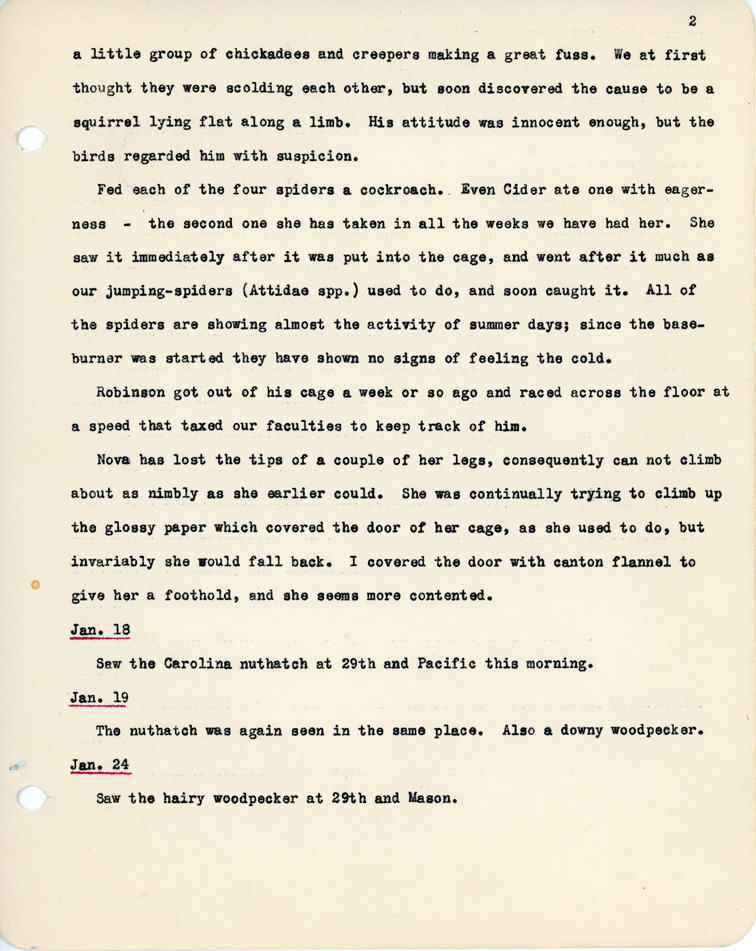
a little group of chickadees and creepers making a great fuss. We at first thought they were scolding each other, but soon discovered the cause to be a squirrel lying flat along a limb. His attitude was innocent enough, but the birds regarded him with suspicion.
Fed each of the four spiders a cockroach. Even Cider ate one with eagerness – the second one she has taken in all th weeks we have had her. She saw it immediately after it was put into the cage, and went after it much as our jumping-spiders (Attidae spp.) used to do, and soon caught it. All of the spiders are showing almost the activity of summer days; since the baseburner was started they have shown no signs of feeling the cold.
Robinson got out of his cage a week or so ago and raced across the floor at a speed that taxed our faculties to keep track of him.
Nova has lost the tips of a couple of her legs, consequently can not climb about as nimbly as she earlier could. She was continually trying to climb up the glossy paper which ocvered the door of her cage, as she used to do, but invariably she would fall back. I covered the door with canton flannel to give her a foothold, and she seems more contented.
Jan 18.
Saw the Carolina nuthatch at 29th and Pacific this morning.
Jan 19.
The nuthatch was again seen in the same place. Also a downy woodpecker.
Jan. 24
Saw the hairy woodpecker at 29th and Mason.
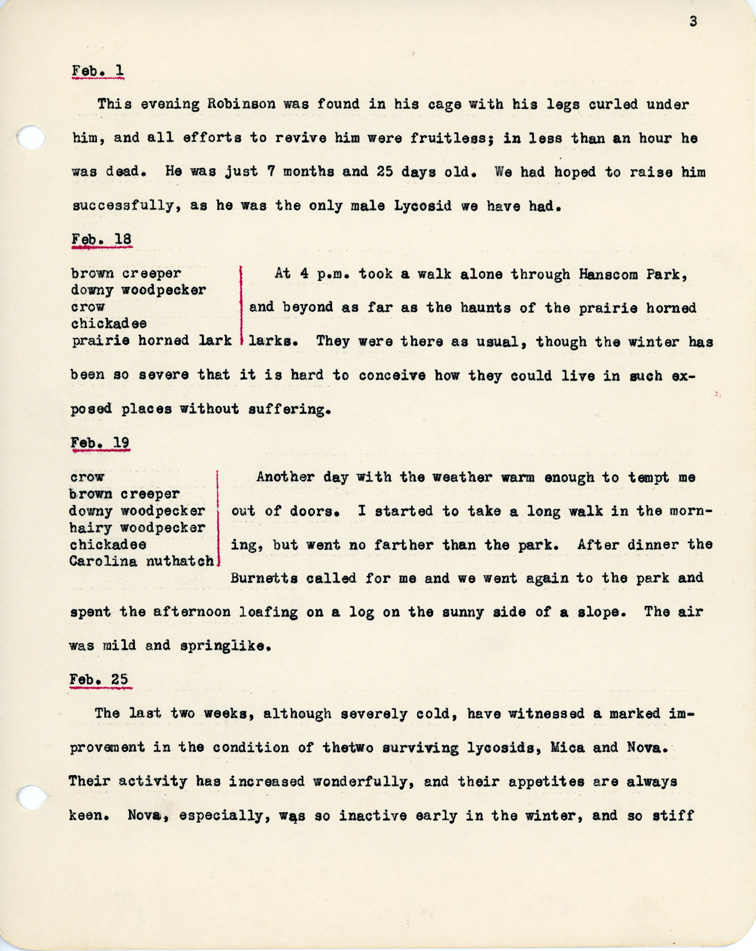
Feb. 1
This evening Robinson was found in his cage with his legs curled under him, and all efforts to revive him were fruitless; in less than an hour he was dead. He was just 7 months and 25 days old. We had hoped to raise him successfully, as he was the only male Lycosid we have had.
Feb. 18
brown creeper downy woodpecker crow chickadee prairie horned lark
At 4 p.m. took a walk alone through Hanscom Park, and beyond as far as the haunts of the prairie horned larks. They were there as usual, though the winter has been so severe that it is hard to conceive how they could live in such exposed places without suffering.
Feb. 19
crow brown creeper downy woodpecker hairy woodpecker chickadee Carolina nuthatch
Another day with the weather warm enough to tempt me out of doors. I started to take a long walk in the morning, but went no farther than the park. After dinner the Burnetts called for me and we went again to the park and spent the afternoon loafing on a log on the sunny side of a slope. The air was mild and springlike.
Feb. 25
The last two weeks, although severely cold, have witnessed a marked improvement in the condition of thetwo [sic] surviving lycosids, Mica and Nova. Their activity has increased wonderfully, and their appetites are always keen. Nova, especially, was so inactive early in the winter, and so stiff
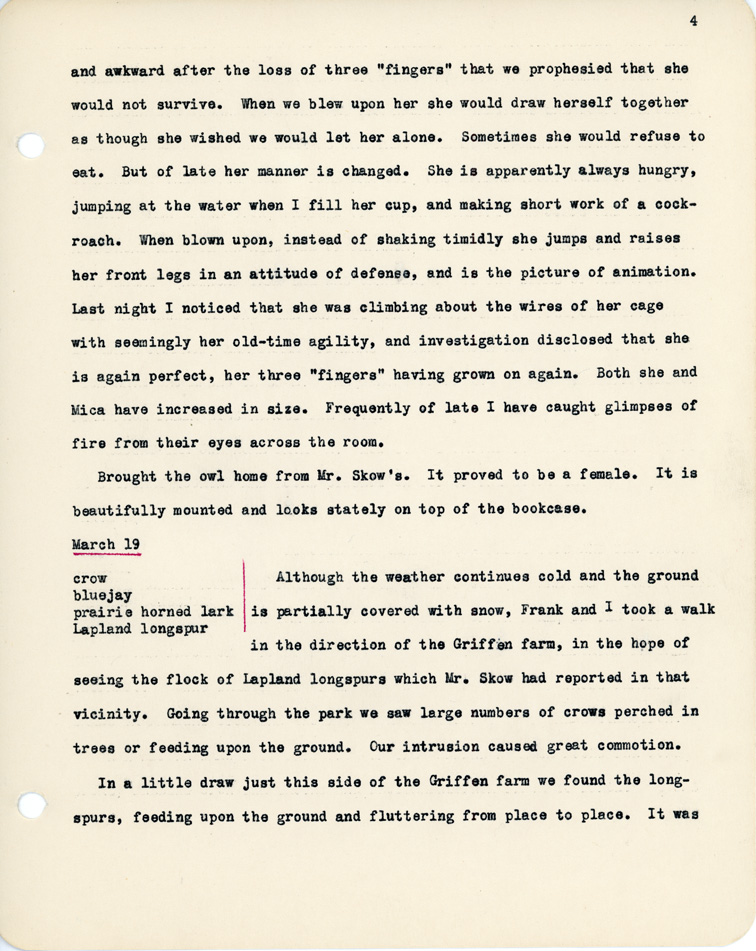
And awkward after the loss of three “fingers” that we prophesied that she would not survive. When we blew upon her she would draw herself together as though she wished we would let her alone. Sometimes she would refuse to eat. But of late her manner is changed. She is apparently always hungry, jumping at the water when I fill her cup, and making short work of a cockroach. When blown upon, instead of shaking timidly she jumps and raises her front legs in an attitude of defense, and is the picture of animation. Last night I noticed that she was climbing about the wires of her cage with seemingly her old-time agility, and investigation disclosed that she is again perfect, her three “fingers” having grown on again. Both she and Mica have increased in size. Frequently of late I have caught glimpses of fire from their eyes across the room.
Brought the owl home from Mr. Skow’s. It proved to be a female. It is beautifully mounted and looks stately on top of the bookcase.
March 19
crow
bluejay
prairie horned lark
Lapland longspur
Although the weather continues cold and the ground is partially covered with snow, Frank and I took a walk in the direction of the Griffen farm, in the hope of seeing the flock of Lapland longspurs which Mr. Skow had reported in that vicinity. Going through the park we saw large numbers of crows perched in trees or feeding upon the ground. Our intrusion caused great commotion.
In a little draw just this side of the Griffen farm we found the longspurs, feeding upon the ground and fluttering from place to place. It was
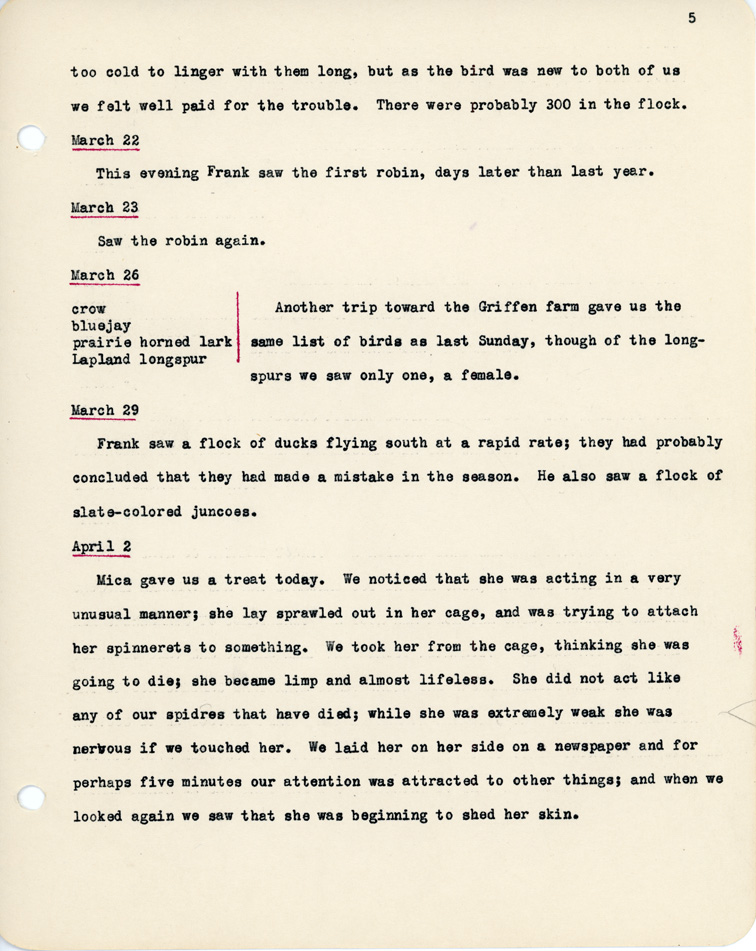
Too cold to linger with them long, but as the bird was new to both of us we felt well paid for the trouble. There were probably 300 in the flock.
March 22
This evening Frank saw the first robin, days later than last year.
March 23
Saw the robin again.
March 26
crow
bluejay
prairie horned lark
Lapland longspur
Another trip toward the Griffen farm gave us the same list of birds as last Sunday, though of the longspurs we saw only one, a female.
March 29
Frank saw a flock of ducks flying south at a rapid rate; they had probably concluded that they had made a mistake in the season. He also saw a flock of slate-colored juncos.
April 2
Mica gave us a treat today. We noticed that she was acting in a very unusual manner; she lay sprawled out in her cage, and was trying to attach her spinnerets to something. We took her from the cage, thinking she was going to die; she became limp and almost lifeless. She did not act like any of our spidres [sic] that have died; while she was extremely weak she was nervous if we touched her. We laid her on her side on a newspaper and for perhaps five minutes our attention was attracted to other things; and when we looked again we saw that she was beginning to shed her skin.
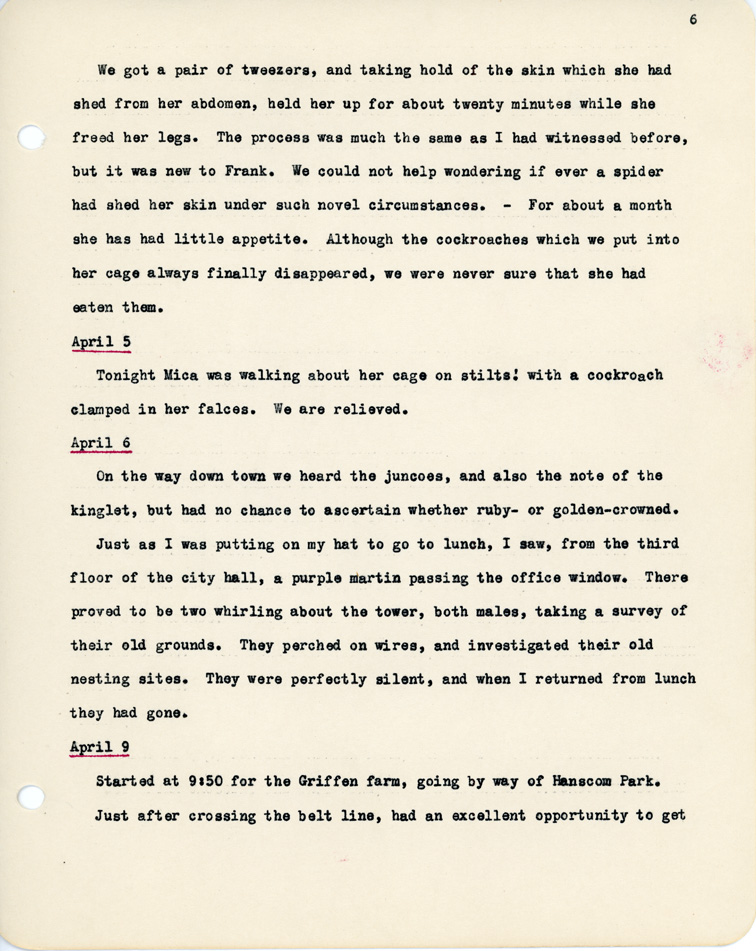
We got a pair of tweezers, and taking hold of the skin which she had shed from her abdomen, held her up for about twenty minutes while she freed her legs. The process was much the same as I had witnessed before, but it was new to Frank. We could not help wondering if ever a spider had shed her skin under such novel circumstances. – For about a month she has had little appetite. Although the cockroaches which we put into her cage always finally disappeared, we were never sure that she had eaten them.
April 5
Tonight Mica was walking about her cage on stilts! with [sic] a cockroach clamped in her falces. We are relieved.
April 6
On the way down town we heard the juncos, and also the note of the kinglet, but had no chance to ascertain whether ruby- or golden-crowned.
Just as I was putting on my hat to go to lunch, I saw, from the third floor of the city hall, a purple martin passing the office window. There proved to be two whirling about the tower, both males, taking a survey of their old grounds. They perched on wires, and investigated their old nesting sites. They were perfectly silent, and when I returned from lunch they had gone.
April 9
Start at 9:50 for the Griffen farm, going by way of Hanscom Park. Just after crossing the belt line, had an excellent opportunity to get
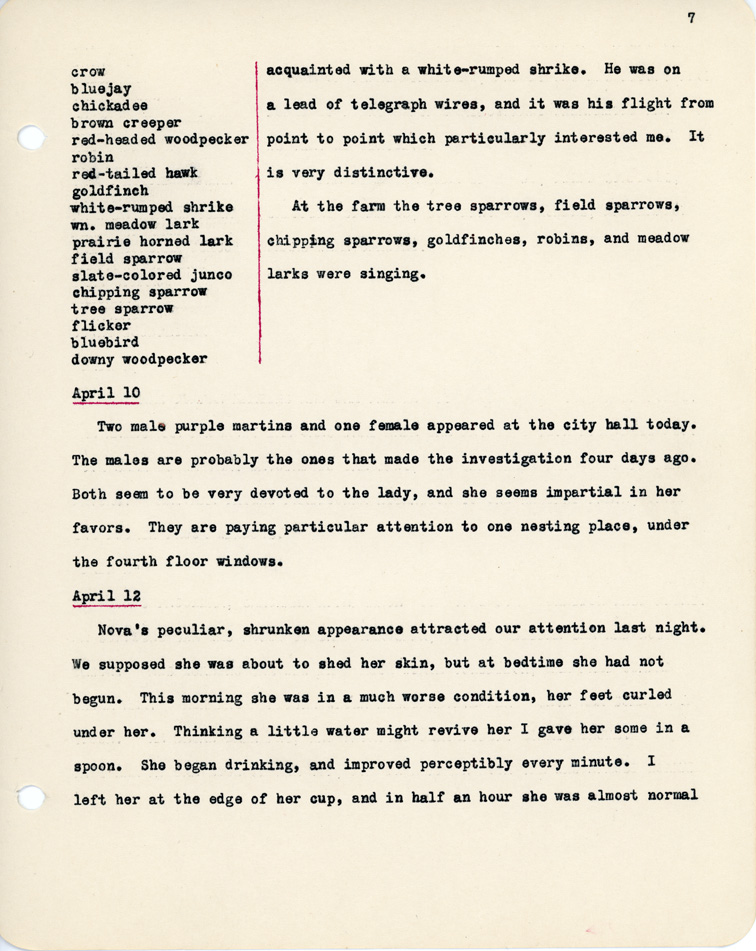
crow
bluejay
chickadee
brown creeper
red-headed woodpecker
robin
red-tailed hawk
goldfinch
white-rumped shrike
wn. meadow lark
prairie horned lark
field sparrow
slate-colored junco
chipping sparrow
tree sparrow
flicker
bluebird
downy woodpecker
acquainted with a white-rumped shrike. He was on a lead of telegraph wires, and it was his flight from point to point which particularly interested me. It is very distinctive.
At the farm the tree sparrows, field sparrows, chipping sparrows, goldfinches, robins, and meadow larks were singing.
April 10
Two male purple martins and one female appeared at the city hall today. The males are probably the ones that made the investigation four days ago. Both seem to be very devoted to the lady, and she seems impartial in her favors. They are paying particular attention to one nesting place, under the fourth floor windows.
April 12
Nova’s peculiar, shrunken appearance attracted our attention last night. We supposed she was about to shed her skin, but at bedtime she had not begun. This morning she was in a much worse condition, her feet curled under her. Thinking a little water might revive her I gave her some in a spoon. She began drinking, and improved perceptibly every minute. I left her at the edge of her cup, and in half an hour she was almost normal
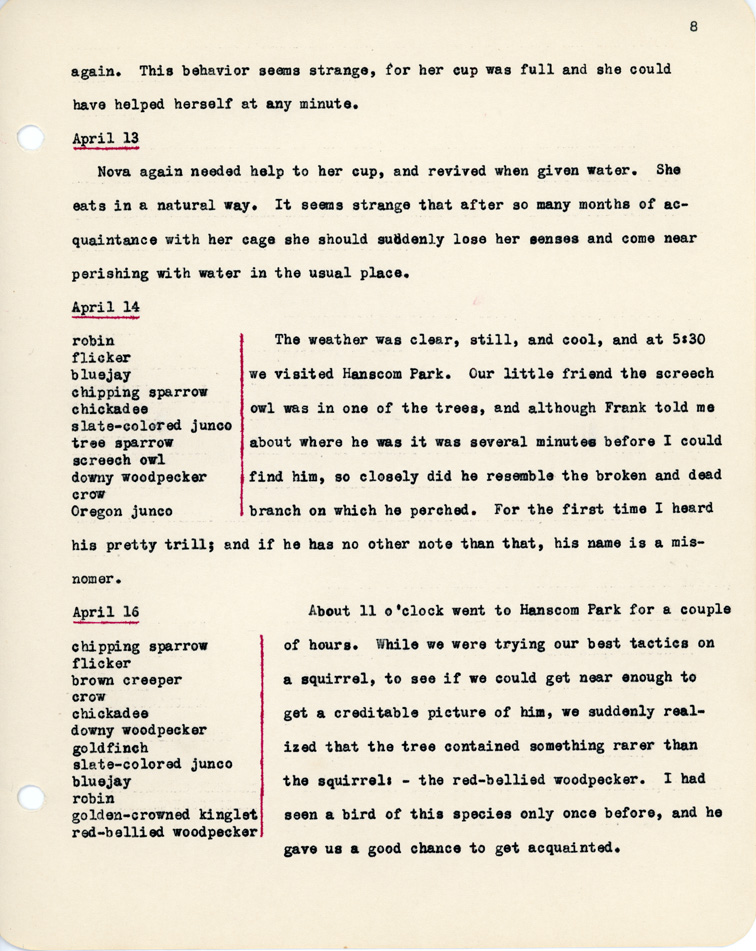
again. This behavior seems strange, for her cup was full and she could have helped herself at any minute.
April 13
Nova again needed helped with her cup, and revived when given water. She eats in a natural way. It seems strange that after so many months of acquaintance with her cage she should suddenly lose her senses and come near perishing with water in the usual place.
April 14
robin
flicker
bluejay
chipping sparrow
chickadee
slate-colored junco
tree sparrow
screech owl
downy woodpecker
crow
Oregon junco
The weather was clear, still, and cool, and at 5:30 we visited Hanscom Park. Our little friend the screech owl was in one of the trees, and although Frank told me about where he was it was minutes before I could find him, so closely did he resemble the broken and dead branch on which he perched. For the first time I heard his pretty trill; and if he has no other note than that, his name is a misnomer.
April 16
chipping sparrow
flicker
brown creeper
crow
chickadee
downy woodpecker
goldfinch
slate-colored junco
bluejay
robin
golden-crowned kinglet
red-bellied woodpecker
About 11 o’clock went to Hanscom Park for a couple of hours. While we were trying our best tactics on a squirrel, to see if we could get near enough to get a creditable picture of him, we suddenly realized that the tree contained something rarer than the squirrel: – the red-bellied woodpecker. I had seen a bird of this species only once before, and he gave us a good chance to get acquainted.
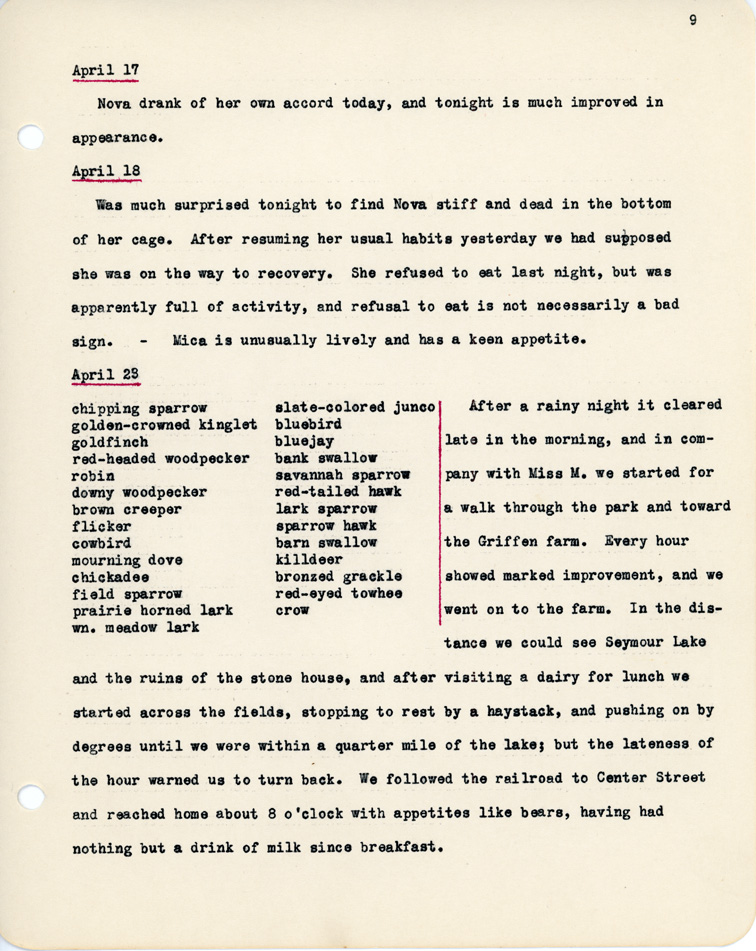
April 17
Nova drank of her own accord today, and tonight is much improved in appearance.
April 18
Was much surprised tonight to find Nova stiff and dead in the bottom of her cage. After resuming her usual habits yesterday we had supposed she was on the way to recovery. She refused to eat last night, but was apparently full of activity, and refusal to eat is not necessarily a bad sign. – Mica is unusually lively and has a keen appetite.
April 28
chipping sparrow slate-colored junco
golden-crowned kinglet bluebird
goldfinch bluejay
red-headed woodpecker bank swallow
robin savannah sparrow
downy woodpecker red-tailed hawk
brown creeper lark sparrow
flicker sparrow hawk
cowbird barn swallow
mourning dove killdeer
chickadee bronzed grackle
field sparrow red-eyed towhee
prairie horned lark crow
wn. meadow lark
After a rainy night it cleared late in the morning, and in company with Miss M. we started for a walk through the park and toward the Griffen farm. Every hour showed marked improvement, and we went on to the farm. In the distance we could see Seymour Lake and the ruins of the stone house, and after visiting a dairy for lunch we started across the fields, stopping to rest by a haystack, and pushing on by degrees until we were within a quarter mile of the lake; but the lateness of the hour warned s to turn back. We followed the railroad to Center Street and reached home about 8 o’clock with appetites like bears, having had nothing but a drink of milk since breakfast.
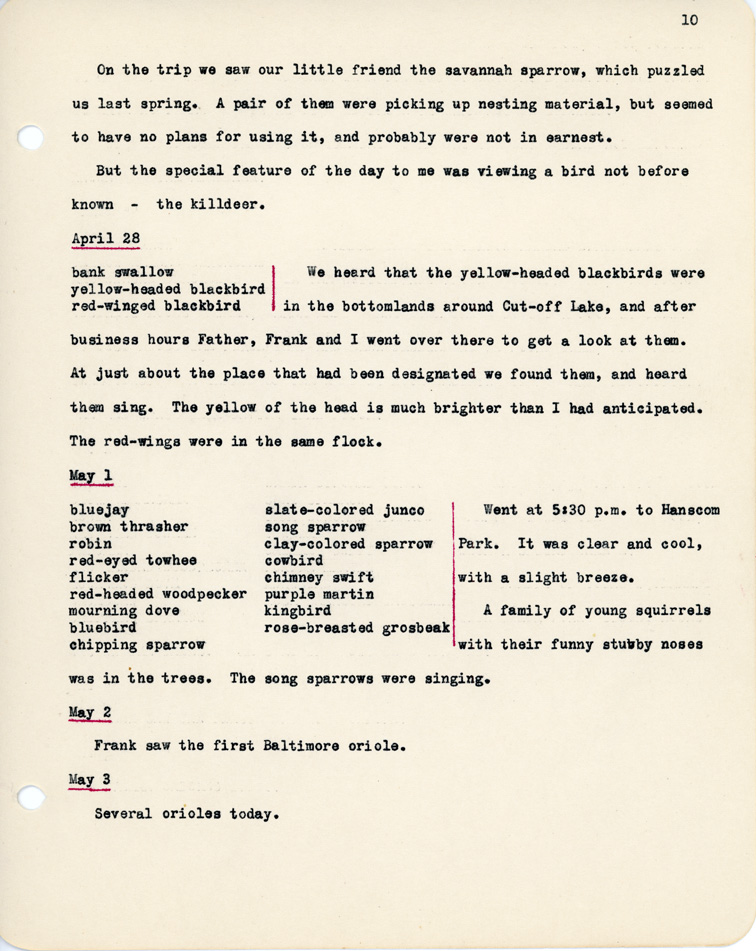
On the trip we saw our little friend the savannah sparrow, which puzzled us last spring. A pair of them were picking up nesting material, but seemed to have no plans for using it, and probably were not in earnest.
But the special feature of the day to me was viewing a bird not before known – the killdeer.
April 28
bank swallow
yellow-headed blackbird
red-winged blackbird
We heard that the yellow-headed blackbirds were in the bottomlands around Cut-off Lake, and after business hours Father, Frank and I went over there to get a look at them. At just about the place that had been designated we found them, and heard them sing. The yellow of the head is much brighter than I had anticipated. The red-wings were in the same flock.
May 1
bluejay slate-colored junco
brown thrasher song sparrow
robin clay-colored sparrow
red-eyed towhee cowbird
flicker chimney swift
red-headed woodpecker purple martin
mourning dove kingbird
bluebird rose-breasted grosbeak
cowbird barn swallow
chipping sparrow
Went at 5:30 p.m. to Hanscom Park. It was clear and cool, with a slight breeze.
A family of young squirrels with their funny stubby noses was in the trees. The spong sparrows were singing.
May 2
Frank saw the first Baltimore oriole.
May 3
Several orioles today.
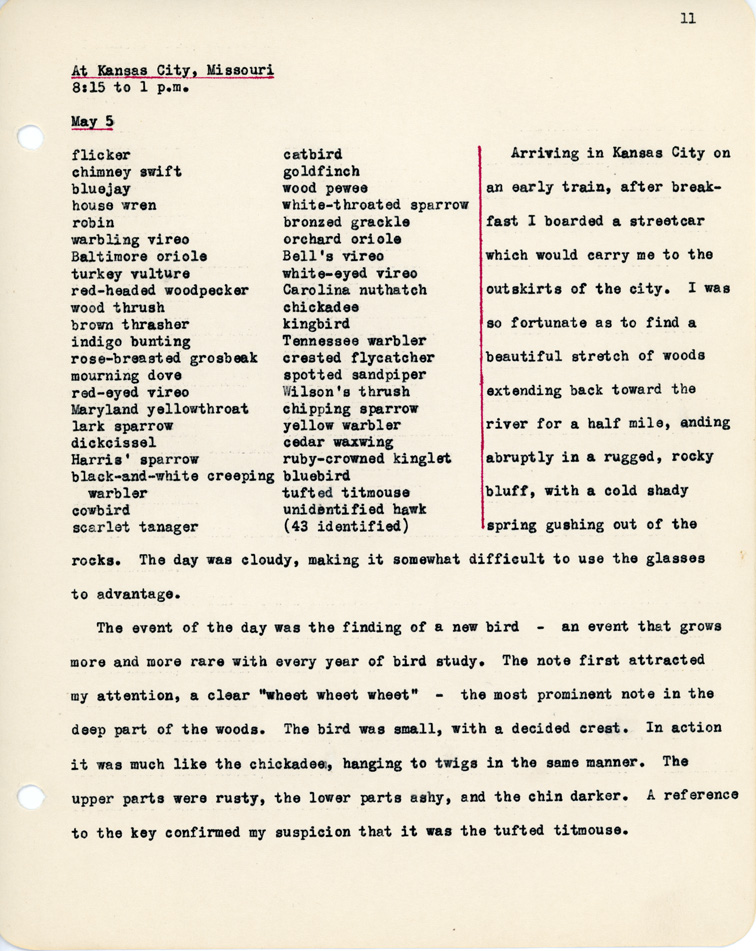
At Kansas City, Missouri
8:15 to 1 p.m.
May 5
flicker catbird
chimney swift goldfinch
bluejay wood pewee
house wren white-throated sparrow
robin bronzed grackle
warbling vireo orchard oriole
Baltimore oriole Bell’s vireo
turkey vulture white-eyed vireo
red-headed woodpecker Carolina nuthatch
wood thrush chickadee
brown thrasher kingbird
indigo bunting Tennessee warbler
rose-breasted grosbeak crested flycatcher
mourning dove spotted sandpiper
red-eyed vireo Wilson’s thrush
Maryland yellowthroat chipping sparrow
lark sparrow yellow warbler
dickcissel cedar waxwing
Harris’ sparrow ruby-crowned kinglet
black-and-white creeping bluebird
warbler tufted titmouse
cowbird unidentified hawk
scarlet tanager (43 identified)
Arriving in Kansas City on an early train, after breakfast I boarded a streetcar which would carry me to the outskirts of the city. I was so fortunate as to find a beautiful stretch of woods extending back toward the river for a half mile, ending abruptly in a rugged, rocky bluff, with a cold shady spring gushing out of the rocks. The day was cloudy, making it somewhat difficult to use the glasses to advantage.
The event of the day was the finding of a new bird – an event that grows more and more rare with every year of bird study. The note first attracted my attention, a clear “wheet wheet wheet” – the most prominent note in the deep part of the woods. The bird was small, with a decided crest. In action it was much like the chickadee, hanging to twigs in the same manner. The upper parts were rusty, the lower parts ashy, and the chin darker. A reference to the key confirmed my suspicion that it was the tufted titmouse.
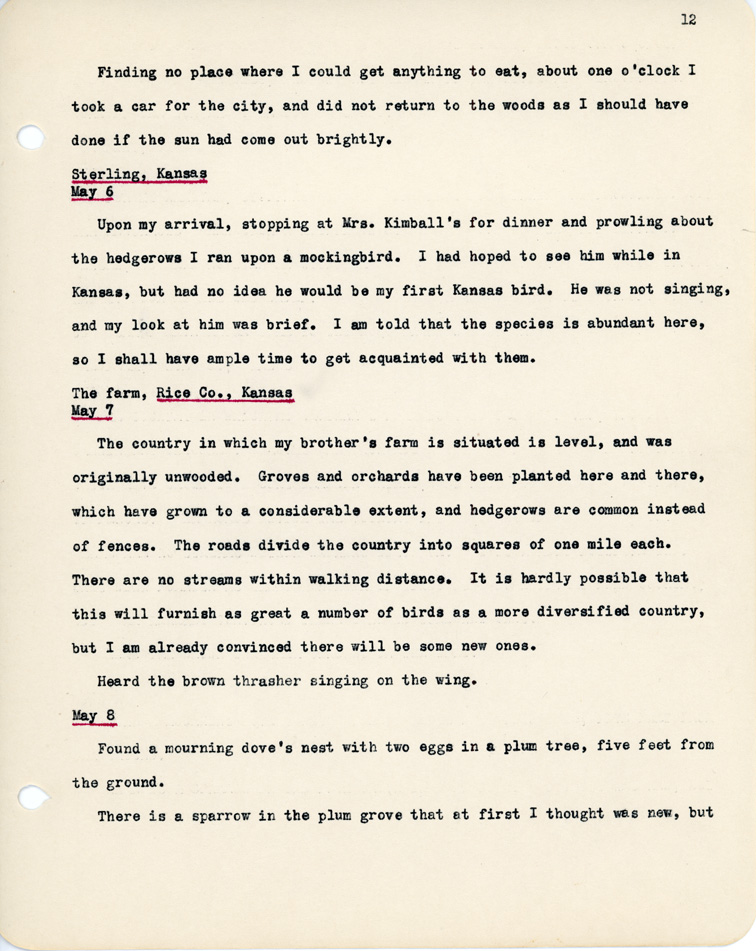
Finding no place where I could get anything to eat, about one o’clock I took a car for the city, and did not return to the woods as I should have done if the sun had come out brightly.
Sterling, Kansas
May 6
Upon my arrival, stopping at Mrs. Kimball’s for dinner and prowling about the hedgerows I ran upon a mockingbird. I had hoped to see him while in Kansas, but had no idea he would be my first Kansas bird. He was not singing, and my look at him was brief. I am told that the species is abundant here, so I shall have ample time to get acquainted with them.
The farm, Rice Co., Kansas
May 7
The country in which my brother’s farm is situated is level, and was originally unwooded. Groves and orchards have been planted here and there, which have grown to a considerable extent, and hedgerows are common instead of fences. The roads divide the country into squares of one mile each. There are no streams within walking distance. It is hardly possible that this will furnish as great a number of birds as a more diversified country, but I am already conviced there will be some new ones.
Heard the brown thrasher singing on the sing.
May 8
Found a mourning dove’s nest with two eggs in a plum tree, five feet from the ground.
There is a sparrow in the plum grove that at first I thought was new, but
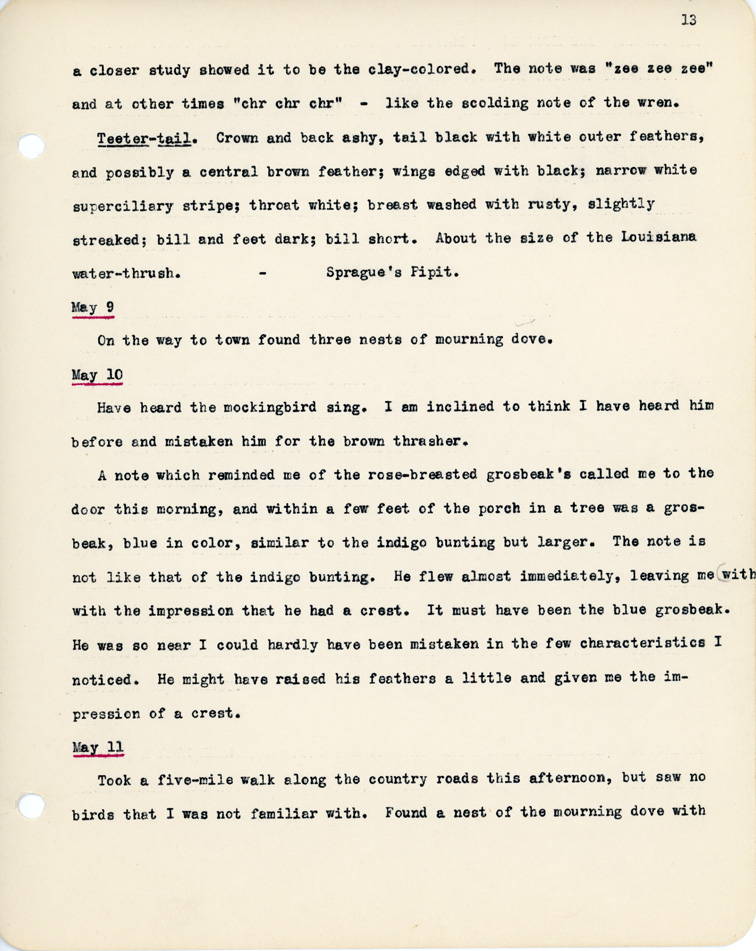
a closer study showed it to be the clay-colored. The note was “zee zee zee” and at other times “chr chr chr” – like the scolding note of the wren.
Teeter-tail. Crown and back ashy, tail black with white outer feathers, and possibly a central brown feather; wings edged with black; narrow white superciliary stripe; throat white; breast washed with rusty, slightly streaked; bill and feet dark; bill short. About the size of the Louisiana water-thrush. – Sprague’s Pipit.
May 9
On the way to town found three nests of mourning dove.
May 10
Have heard the mockingbird sing. I am inclined to think I have heard him before and mistaken him for the brown thrasher.
A note which reminded me of the rose-breasted grosbeak’s called me to the door this morning, and within a few feet of the porch in a tree was a grosbeak, blue in color, similar to the indigo bunting but larger. The note is not like that of the indigo bunting. He flew almost immediately, leaving me (with [sic] with the impression that he had a crest. It must have been the blue grosbeak. He was so near I could hardly have been mistaken in the few characteristics I noticed. He might have raised his feathers a little and given me the impression of a crest.
May 11
Took a five-mile walk along the country roads this afternoon, but saw no birds that I was not familiar with. Found a nest of the mourning dove with
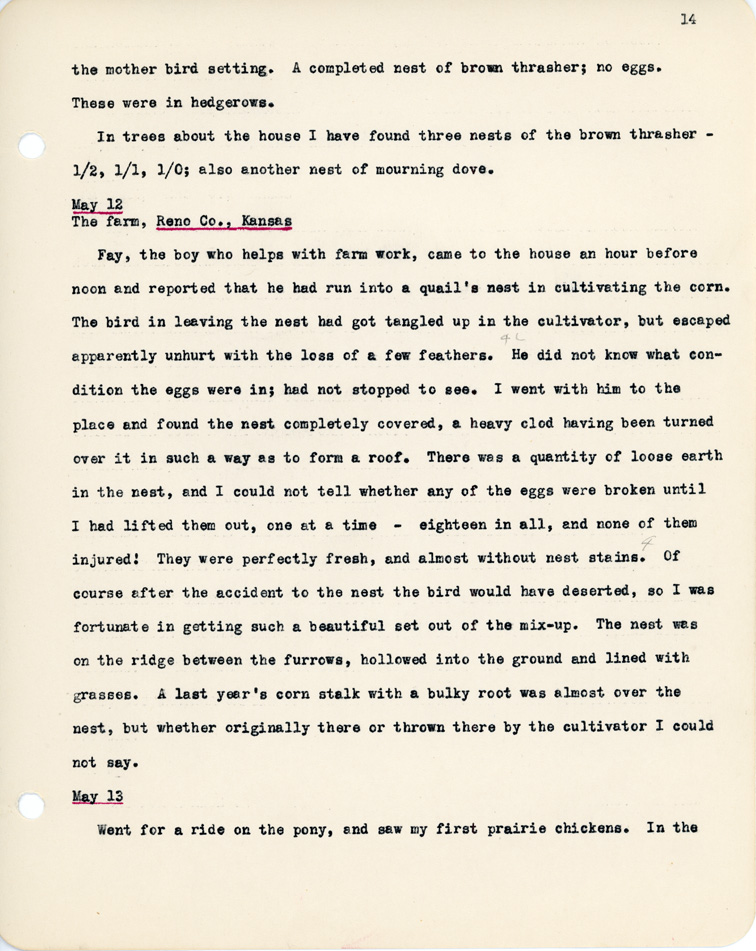
the mother bird setting. A completed nest of brown thrasher; no eggs. These were in hedgerows.
In trees about the house I have found three nests of the brown thrasher – ½, 1/1, 1/0; also another nest of mourning dove.
May 12
The farm, Reno Co., Kansas
Fay, the boy who helps with farm work, came to the house an hour before noon and reported that he had run into a quail’s nest in cultivating the corn. The bird in leaving the nest had got tangled up in the cultivator, but escaped apparently unhurt with the loss of a few feathers. He did not know what condition the eggs were in; had not stopped to see. I went with him to the place and found the completely covered, a heavy clod having been turned over it in such a way as to form a roof. There was a quantity of loose earth in the nest, and I could not tell whether any of the eggs were broken until I had lifted them out, one at a time – eighteen in all, and none of them injured! They were perfectly fresh, and almost without nest stains. Of course after the accident to the nest the bird would have deserted, so I was fortunate in getting such a beautiful set out of the mix-up. The nest was on the ridge between the furrows, hollowed into the ground and lined with grasses. A last year’s corn stalk with a bulky root was almost over the nest, but whether originally three or thrown there by the cultivator I could not say.
May 13
Went for a ride on the pony, and saw my first prairie chickens. In the
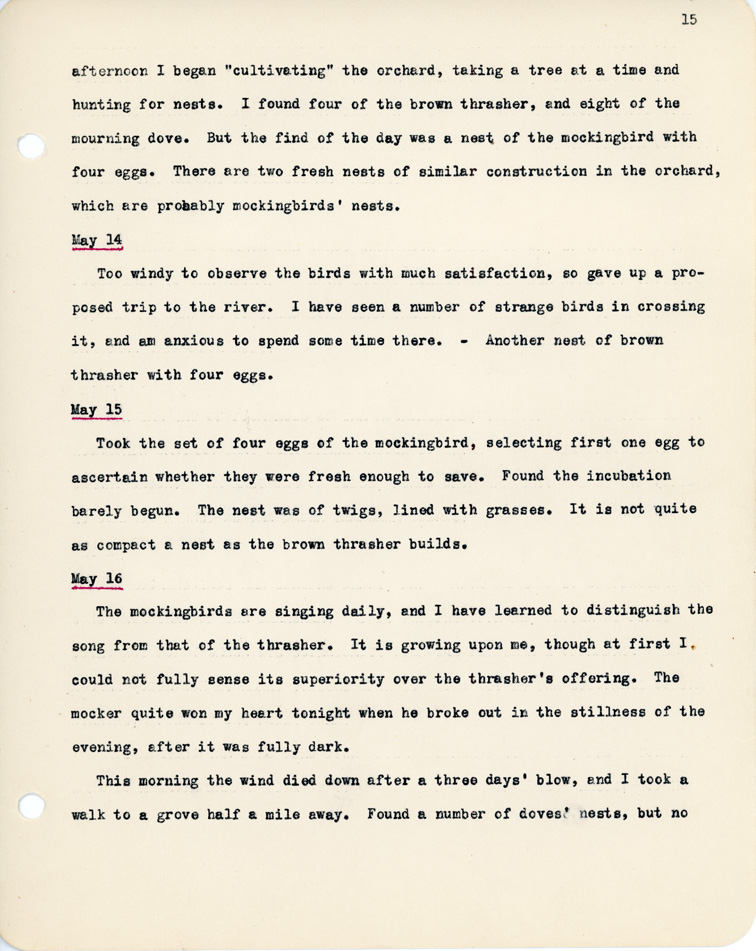
Afternoon I began “cultivating” the orchard, taking at a time and hunting for nests. I found four of the brown thrasher, and eight of the mourning dove. But the find of the day was a nest of the mockingbird with four eggs. There are two fresh nests of similar construction in the orchard, which are probably mockingbirds’ nests.
May 14
Too windy to observe the birds with much satisfaction, so gave up a proposed trip to the river. I have seen a number of strange birds in crossing it, and an anxious to spend some time there. – Another nest of brown thrasher with four eggs.
May 15
Took the set of four eggs of the mockingbird, selecting first one egg to ascertain whether they were fresh enough to save. Found the incubation barely begun. The nest was twigs, lined with grasses. It is not quite as compact a nest as the brown thrasher builds.
May 16
The mockingbirds are singing daily, and I have learned to distinguish the song from that of the thrasher. It is growing upon me, though at first I could not fully sense its superiority over the thrasher’s offering. The mocker quite won my heart tonight when he broke out in the stillness of the evening, after it was fully dark.
This morning the wind died down after a three days’ blow, and I took a walk to a grove half a mile away. Found a number of doves’ nests, but no

others. One nest, instead of the customary frailness, was bulky; which no doubt means that the dove added its sticks to last year’s nest of some other bird. – Twice I walked the full length of an osage orange hedge ¾ mile long, but did not find a single nest of this year’s construction. In another hedge, just at the corner of the road, I found a nest of the white-rumped shrike, and after many lacerations found the contents to be young birds; it was a sticky job to find out even that much, without trying to count them. Both birds were carrying food.
May 17
Bluejays and kingbirds are busy picking potato bugs from the plants. The kingbird take a position on a cornstalk left sticking in the ground and makes a dash when he sees a bug, usually securing it while hovering instead of alighting; but occasionally he lights on the ground and picks them off.
May 18
Again rumors today of bobolinks, and descriptions by members of the community, as on several occasions since my arrival. It would seem that the birds are here all right, but as yet I have not seen one.
May 19
Took a trip to town, and caught a fleeting glimpse of what at the time I supposed to be a bobolink. But on the way home I saw a group of eight of the birds and my illusion was dispelled, as a reference to Coues’ Key proves them to be lark buntings.
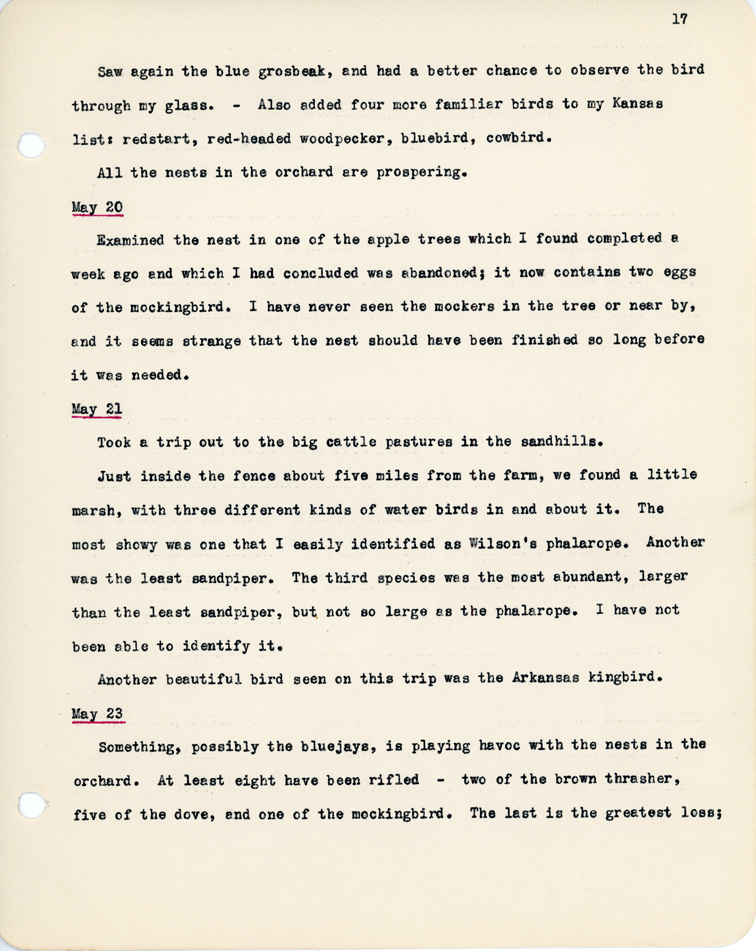
Saw again the blue grosbeak, and had a better chance to observe the bird through my glass. – Also added four more familiar birds to my Kansas list: redstart, red-headed woodpecker, bluebird, cowbird.
All the nests in the orchard are prospering.
May 20
Examined the nest in one of the apple trees which I found completed a week ago and which I had concluded was abandoned; it now contains two eggs of the mockingbird. I have never seen the mockers in the tree or near by, and it seems strange that the nest should have been finished so long before it was needed.
May 21
Took a trip out to the big cattle pastures in the sandhills.
Just inside the fence about five miles from the farm, we found a little marsh, with three different kinds of water birds in and about it. The most showy was one that easily identified as Wilson’s phalarope. Another was the least sandpiper. The third species was the most abundant, larger than the least sandpiper, but not so large as the phalarope. I have not been able to identify it.
Another beautiful bird seen on this trip was the Arkansas kingbird.
May 23
Something, possibly the bluejays, is playing havoc with the nests in the orchard. At least eight have been rifled – two of the brown thrasher, five of the dove, and one of the mockingbird. The last is the great loss;
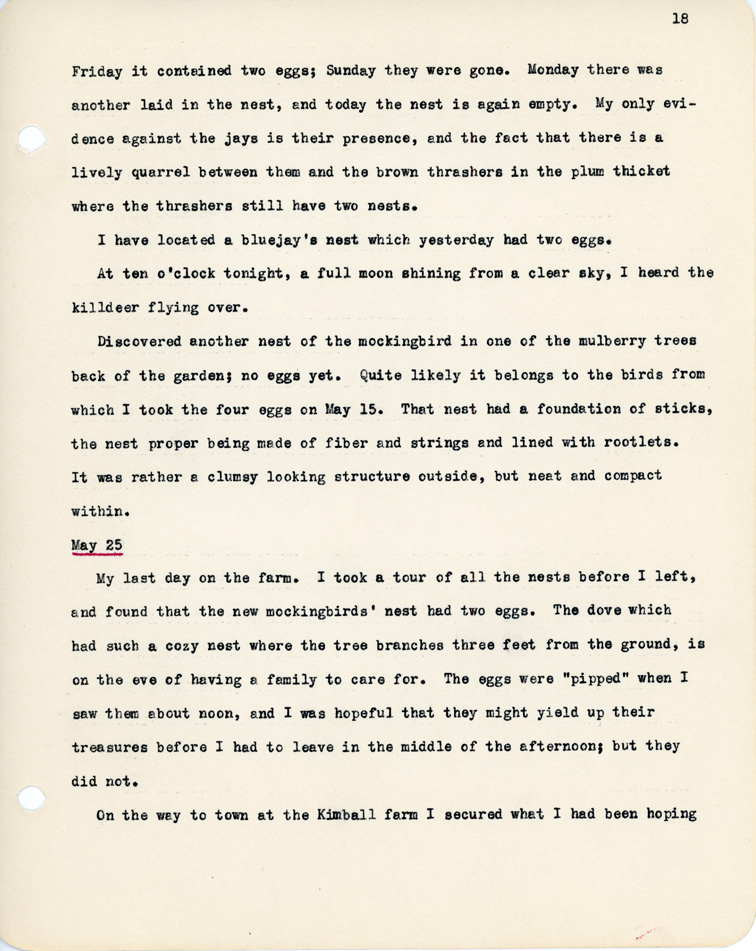
Friday it contained two eggs; Sunday they were gone. Monday there was another laid in the nest, and today the nest is again empty. My only evidence against the jays is their presence, and the fact that there is a lively quarrel between them and the brown thrashers in the plum thicket where the thrashers still have two nests.
I have located a bluejay’s nest which yesterday had two eggs.
At ten o’clock tonight, a full moon shining from a clear sky, I heard the killdeer flying over.
Discovered another nest of the mockingbird in one of the mulberry trees back of the garden; no eggs yet. Quite likely it belongs to birds from which I took the four eggs on May 15. That nest had a foundation of sticks, the nest proper being made of fiber and strings and lined with rootlets. It was rather a clumsy looking structure outside, but neat and compact within.
May 25
My last day on the farm. I took a tour of all the nests before I left, and found that the new mockingbirds’ nest had two eggs. The dove which had such a cozy nest where the tree branches three feet from the ground, is on the eve of having a family to care for. The eggs were “pipped” when I saw them about noon, and I was hopeful that they might yield up their treasures before I had to leave in the middl eof the afternoon; but they did not.
On the way to town at the Kimball farm I secured what I had been hoping
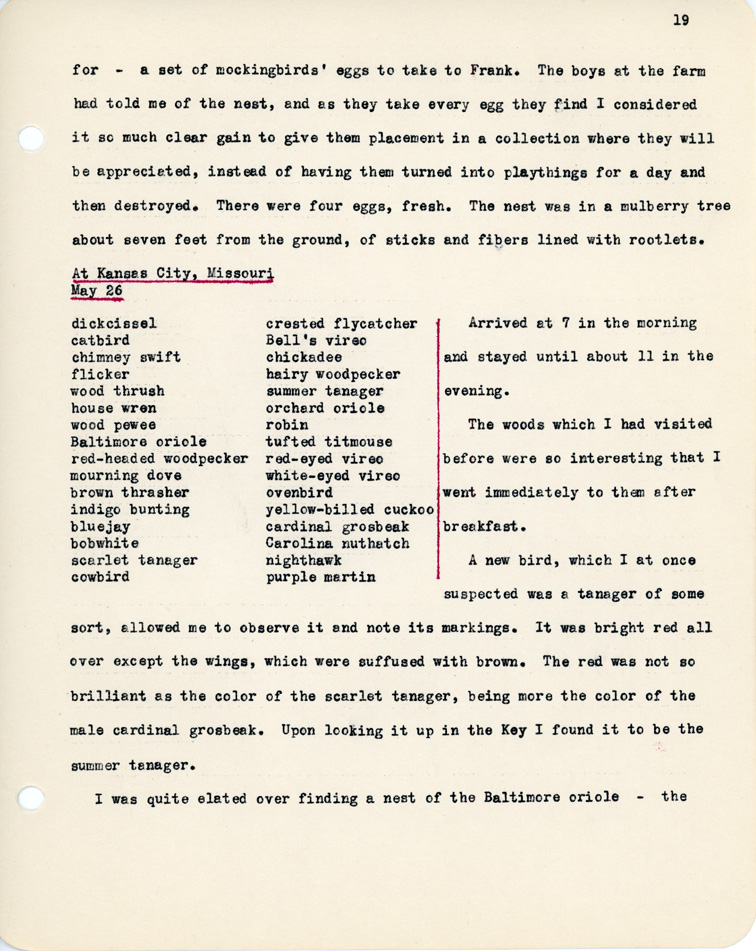
for – a set of mockingbirds’ eggs to take to Frank. The boys at the farm had told me of the nest, and as they take every egg they find I considered it so much clear gain to give them placement in a collection where they will be appreciated, instead of having them turned into playthings for a day and then destroyed. There were four eggs, fresh. The nest was in a mulberry tree about seven feet from the ground, of sticks and fibers lined with rootlets.
At Kansas City, Missouri
May 26
dickcissel crested flycatcher
catbird Bell’s vireo
chimney swift chickadee
flicker hairy woodpecker
wood thrush summer tanager
house wren orchard oriole
wood pewee robin
Baltimore oriole tufted titmouse
red-headed woodpecker red-eyed vireo
mourning dove white-eyed vireo
brown thrasher ovenbird
indigo bunting yellow-billed cuckoo
bluejay cardinal grosbeak
bobwhite Carolina nuthatch
scarlet tanager nighthawk
cowbird purple martin
Arrived at 7 in the morning and stayed until about 11 in the evening.
The woods which I had visited before were so interesting that I went immediately to them after breakfast.
A new bird, which I at once suspected was a tanager of some sort, allowed me to observe it and note its markings. It was bright red all over except the wings, which were suffused with brown. The red was not so brilliant as the color of the scarlet tanager, being more the color of the male cardinal grosbeak. Upon looking it up in the Key I found it to be the summer tanager.
I was quite elated over finding a nest of the Baltimore oriole – the
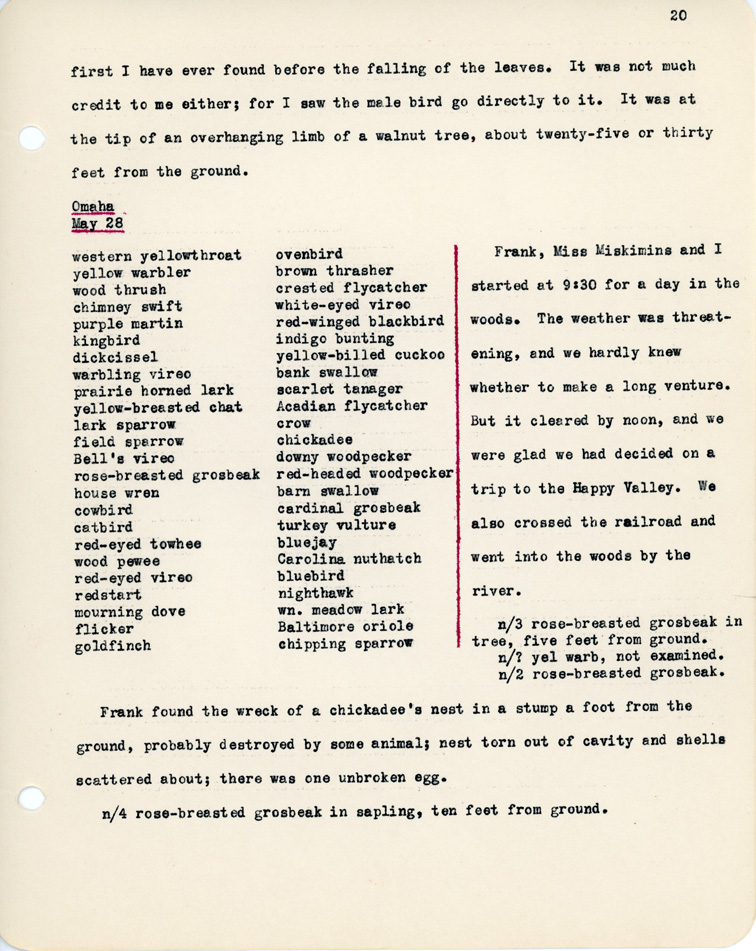
first I have ever found before falling of the leaves. It was not much credit to me either; for I saw the male bird go directly to it. It was at the tip of an overhanging limb of a walnut tree, about twenty-five or thirty feet from the ground.
Omaha
May 28
western yellowthroat ovenbird
yellow warbler brown thrasher
wood thrush crested flycatcher
chimney swift white-eyed vireo
purple martin red-winged blackbird
kingbird indigo bunting
dickcissel yellow-billed cuckoo
warbling vireo bank swallow
prairie horned lark scarlet tanager
yellow-breasted chat acadian flycatcher
lark sparrow crow
field sparrow chickadee
bell’s vireo downy woodpecker
rose-breasted grosbeak red-headed woodpecker
house wren barn swallow
cowbird cardinal grosbeak
catbird turkey vulture
red-eyed towhee bluejay
wood pewee Carolina nuthatch
red-eyed vireo bluebird
redstart nighthawk
mourning dove wn. meadow lark
flicker Baltimore oriole
goldfinch chipping sparrow
Frank, Miss Miskimins and I started at 9:30 for a day in the woods. The weather was threatening, and we hardly knew whether to make a long venture. But it cleared by noon, and we were glad we had decided on a trip to Happy Valley. We also crossed the railroad and went into the woods by the river.
n/3 rose-breasted grosbeak in tree, five feet from ground.
n/? yel warb, not examined.
n/2 rose-breasted grosbeak.
Frank found the wreck of a chickadee’s nest in a stump a foot from the ground probably destroyed by some animal; nest torn out of cavity and shells scattered about; there was one unbroken egg.
n/4 rose-breasted grosbeak in sapling, ten feet from ground.
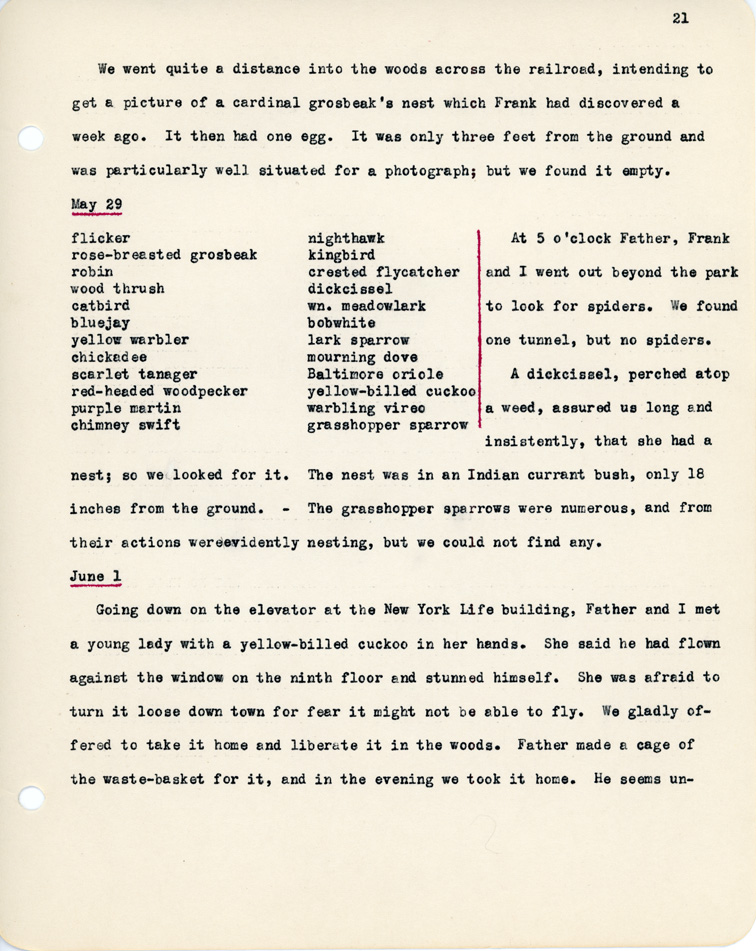
We went quite a distance into the woods across the railroad, intending to get a picture of a cardinal grosbeak’s nest which Frank had discovered a week ago. It then had one egg. It was only three feet from the ground and was particularly well situated for a photograph; but we found it empty.
May 29
flicker nighthawk
rose-breasted grosbeak kingbird
robin crested flycatcher
wood thrush dickcissel
catbird wn. meadowlark
bluejay bobwhite
yellow warbler lark sparrow
chickadee mourning dove
scarlet tanager Baltimore oriole
red-headed woodpecker yellow-billed cuckoo
purple martin warbling vireo
chimney swift grasshopper sparrow
At 5 o’clock Father, Frank and I went out beyond the park to look for spiders. We found one tunnel but no spiders.
A dickcissel, perched atop a weed, assured us long and insistently, that she had a nest; so we looked for it. The nest was in an Indian currant bush, only 18 inches from the ground. – The grasshopper sparrows were numerous, and from their actions were evidently nesting, but we could not find any.
June 1
Going down on the elevator at the New York Life building, Father and I met a young lady with a yellow-billed cuckoo in her hands. She said he had flown against the window on the ninth floor and stunned himself. She was afraid to turn it loose down town for fear it might not be able to fly. We gladly offered to take it home and liberate it in the woods. Father made a cage of the waste-basket for it, and in the evening we took it home. He seems un-
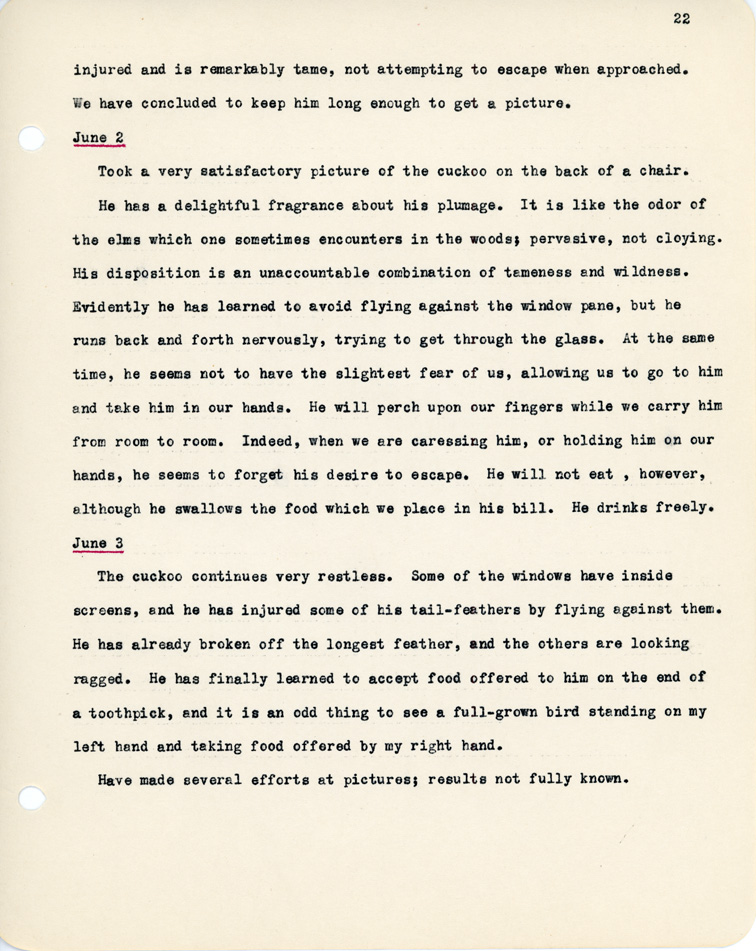
Injured and is remarkably tame, not attempting to escape when approached. We have concluded to keep him long enough to get a picture.
June 2
Took a very satisfactory picture of the cuckoo on the back of a chair.
He has a delightful fragrance about his plumage. It is like the odor of the elms which one sometimes encounters in the woods; pervasive, not cloying. His disposition is an unaccountable combination of tameness and wildness. Evidently he has learned to avoid flying against the window pane, but he runs back and forth nervously, trying to get through the glass. At the same time, he seems not to have the slightest fear of us, allowing us to go to him and take him in our hands. He will perch upon our fingers while we carry him from room to room. Indeed, when we are caressing him, or holding him on our hands, he seems to forget his desire to escape. He will not eat , [sic] however, although he swallows the food which we place in his bill. He drinks freely.
June 3
The cuckoo continues very restless. Some of the windows have inside screens, and he has injured some of his tail-feathers by flying against them. He has already broken off the longest feather, and the others are looking ragged. He ahs finally learned to accept food offered to him on the end of a toothpick, and it is an odd thing to see a full-grown bird standing on my left hand and taking food offered by my right hand.
Have made several efforts at pictures; results not fully known.
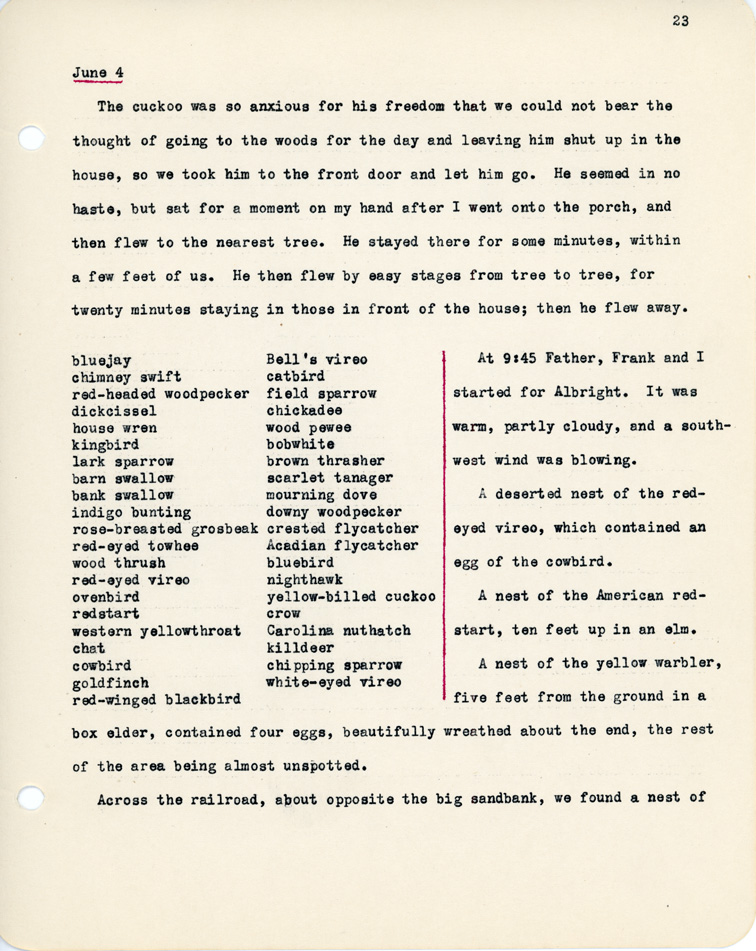
June 4
The cuckoo was so anxious for his freedom that we could not bear the thought of going to the woods for the day and leaving him shut up in the house, so we took him to the front door and let him go. He seemed in no haste, but sat for a moment on my hand after I went onto the porch, and then flew to the nearest tree. He stayed there for some minutes, within a few feet of us. He then flew by easy stages from tree to tree, for twenty minutes staying in those in front of the house; then he flew away.
bluejay Bell’s vireo
chimney swift catbird
red-headed woodpecker field sparrow
dickcissel chickadee
house wren wood pewee
kingbird bobwhite
lark sparrow brown thrasher
barn swallow scarlet tanager
bank swallow mourning dove
indigo bunting downy woodpecker
rose-breasted grosbeak crested flycatcher
red-eyed towhee Acadian flycatcher
wood thrush bluebird
red-eyed vireo nighthawk
ovenbird yellow-billed cuckoo
redstart crow
western yellowthroat Carolina nuthatch
chat killdeer
cowbird chipping sparrow
goldfinch white-eyed vireo
red-winged blackbird
At 9:45 Father, Frank and I started for Albright. It was warm, partly cloudy, and a southwest wind was blowing.
A deserted nest of the red-eyed vireo, which contained an egg of the cowbird.
A nest of the American red-start, ten feet up in an elm.
A nest of the yellow warbler, five feet from the ground in a box elder, contained four eggs, beautifully wreathed about the end, the rest of the area being almost unspotted.
Across the railroad, about opposite the big sandbank, we found a nest of

the yellow-breasted chat with three eggs. We made it the subject of our first nest picture of the day, taking two pictures.
Frank strolled up the Happy Valley alone, and seeing a small rotten stub four or five feet high with a hole in it, he broke it off, intending to show us what the excavation of a downy woodpecker looks like. He was much surprised, upon breaking open the cavity, to find five eggs of the chickadee with incubation well begun. He had no idea of the cavity being occupied so late in the season as both the woodpecker and the chickadee generally nest much earlier. There was nothing that could be done to repair the damage. By a patient effort later he managed to save the set complete, and the stub about 3 ½ inches in diameter we took with us.
Nest of the red-eyed vireo, suspended in the fork of a twig on a lateral branch in a small tree, twelve feet from the ground. Its position was very conspicuous. The bird was on the nest.
June 5
Today we set up the two-foot stub out of doors, replaced the five eggs of the chickadee before preparing them for preservation, and took a photograph. It makes a pretty panel picture, the eggs visible through the side which had been broken away.
June 8
Our home is a rented cottage at 1135 Georgia Avenue, a bit less than two miles from the business center of Omaha where our duties call us. Father and Frank and I almost always walk down town together, and on each occasion make
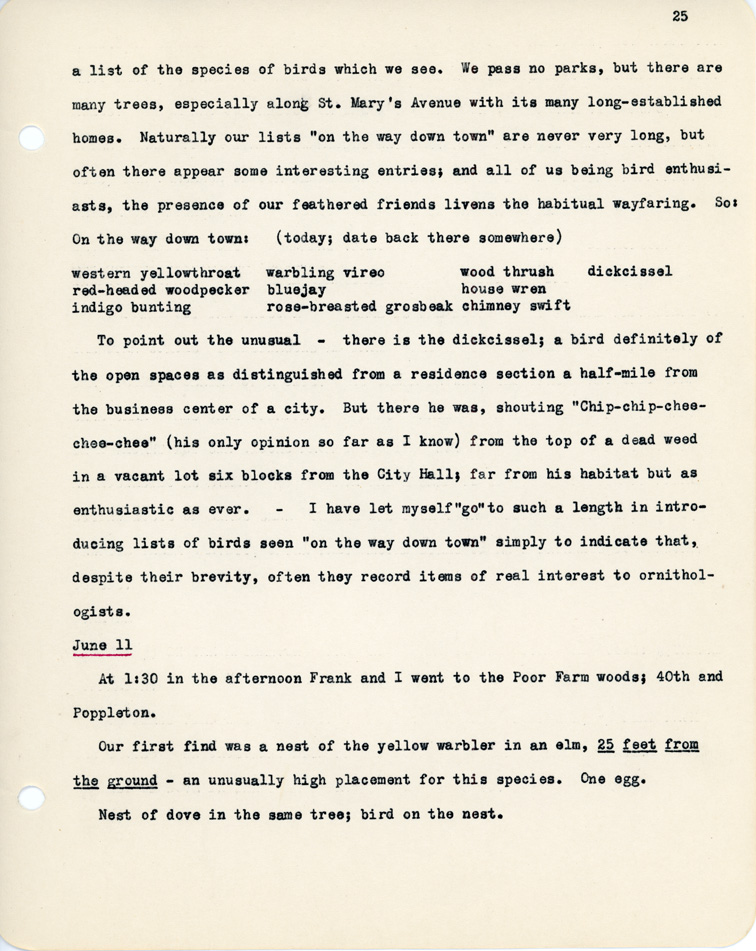
A list of the species of birds which we see. We pass no parks, but there are many trees, especially along St. Mary’s Avenue with its many long-established homes. Naturally our lists “on the way down town” are never very long, but often there appear some interesting entries; and all of us being bird enthusiasts, the presence of our feathered friends livens the habitual wayfaring. So:
One the way down town: (today; date back there somewhere)
western yellowthroat warbling vireo wood thrush dickcissel
red-headed woodpecker bluejay house wren
indigo bunting rose-breasted grosbeak chimney swift
To point out the unusual– there is the dickcissel; a bird definitely of the open spaces as distinguished from a residence section a half-mile from the business center of the city. But there he was, shouting “Chip-chip-chee-chee-chee” (his only opinion as far as I know) from the top of a dead weed in a vacant lot six blocks from the City Hall; far from his habitat but as enthusiastic as ever. – I have let myself”go”to [sic] such a length in introducing lists of birds seen “on the way down town” simply to indicate that, depsite their brevity, often they record items of real interest to ornithologists.
June 11
At 1:30 in the afternoon Frank and I went the Poor Farm woods; 40th and Poppleton.
Our first find was nest of the yellow warbler in an elm, 25 feet from the ground – an unusually high placement or this species. One egg.
Nest of dove in the same tree; bird on the nest.
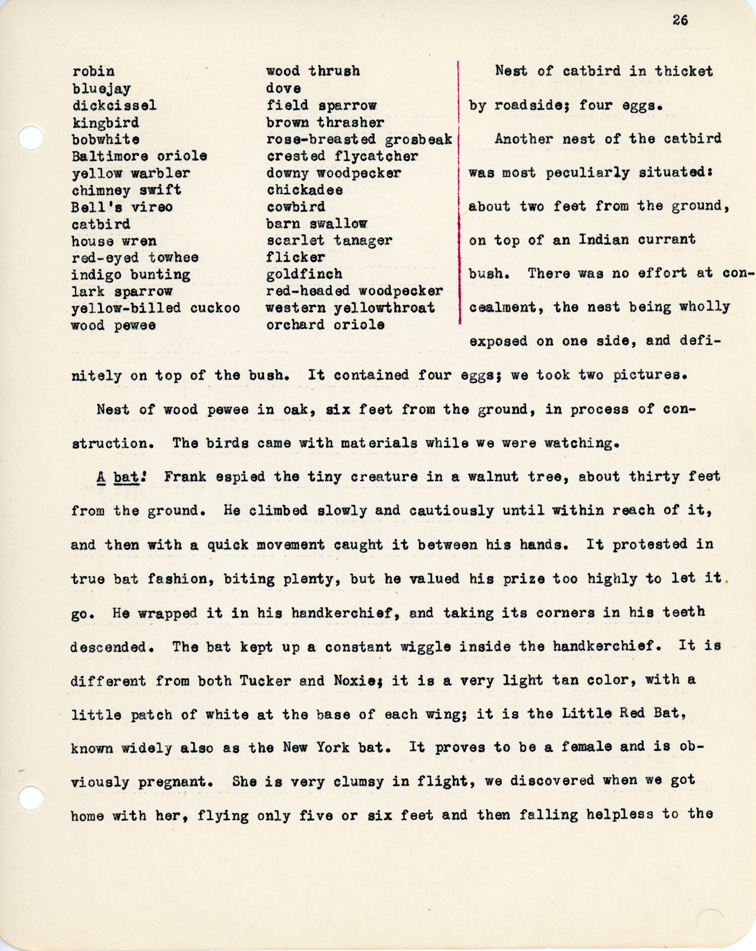
robin wood thrush
bluejay dove
dickcissel field sparrow
kingbird brown thrasher
bobwhite rose-breasted grosbeak
Baltimore oriole crested flycatcher
yellow warbler downy woodpecker
chimney swift chickadee
Bell’s vireo cowbird
catbird barn swallow
house wren scarlet tanager
red-eyed towhee flicker
indigo sparrow red-headed woodpecker
yellow-billed cuckoo western yellowthroat
wood pewee orchard oriole
Nest of catbird in thicket by roadside; four eggs.
Another nest of the catbird was most peculiarly situated: about two feet from the ground, on top of an Indian currant bush. There was no effort at concealment, the nest being wholly exposed on one side, and definitely on top of the bush. It contained four eggs; we took two pictures.
Nest of wood pewee in oak, six feet from the ground, in process of construction. The birds came with materials while we were watching.
A bat! Frank espied the tiny creature in a walnut tree, about thirty feet from the ground. He climbed slowly and cautiously until within reach of it, and then with a quick movement caught It between his hands. It protested in true bat fashion, biting plenty, but he valued his prize too highly to let it go. He wrapped it in his handkerchief, and taking its corners in his teeth descended. The bat kept up a constant wiggle inside the handkerchief. It is different from both Tucker and Noxie; it is a very light tan color, with a little patch of white at the base of each wing; it is the Little Red Bat, known widely also as the New York bat. It proves to be a female and is obviously pregnant. She is very clumsy in flight, we discovered when we got home with her, flying only five or six feet and then falling helpless to the
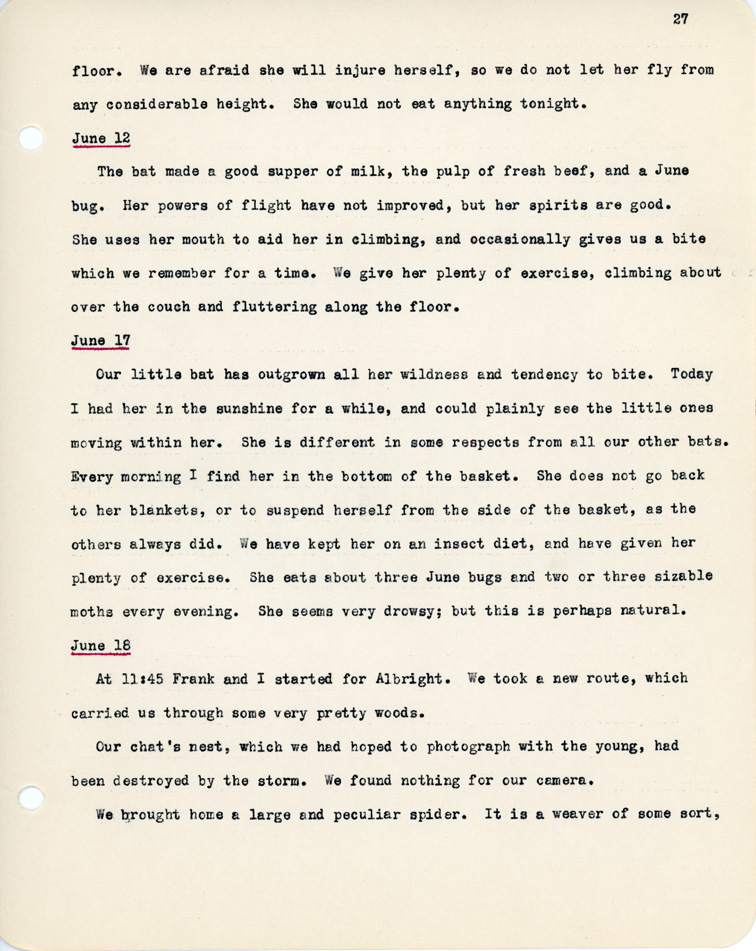
floor. We are afraid she will injure herself, so we do not let her fly from any considerable height. She would not eat anything tonight.
June 12
The bat made a good supper of milk, the pulp of fresh beef, and a June bug. Her powers of flight have not improved, but her spirits are good. She uses her mouth to aid her in climbing, and occasionally gives us a bite which we remember for a time. We give her plenty of exercise, climbing about over the couch and fluttering along the floor.
June 17
Our little bat has outgrown all her wildness and tendency to bite. Today I had her in the sunshine for a while, and could plainly see the little ones moving within her. She is different in some respects from all our other bats. Every morning I find her in the bottom of the basket. She does not go back to her blankets, or to suspend herself from the side of the basket, as the others always did. We have kept her on an insect diet, and have given her plenty of exercise. She eats about three June bugs and two or three sizable moths every evening. She seems very drowsy; but this is perhaps natural.
June 18
At 11:45 Frank and I started for Albright. We took a new route, which carried us through some very pretty woods.
Our chat’s nest, which we had hoped to photograph with the young, had been destroyed by the storm. We found nothing for our camera.
We brought home a large and peculiar spider. It is a weaver of some sort,

gray in color, with two sharp humps of the fore part of the dorsal side of its abdominal section. We have given it a cage and it has spun threads here and there, but has made no effort to weave an orb.
June 19
Our little bat died tonight. She had gradually grown less active, until the last evening or two she would stay awake for only a few minutes. At five o’clock I found her hanging to her blanket by one foot, the other drawn close to her body. I took her in my hands, and she seemed perfectly natural. I hung her back on the blankets, but when I next looked at her, about seven o’clock, she was lying on the bottom of the basket dead, with the same little leg drawn up to her body. Last night she seemed loth to take any exercise, and it was only by an effort that we got her awake enough to flutter about the couch for a moment. I remember having been surprised that I could not see or feel any movement of the young; previously when I had held her in my hand I could always feel and sometimes see their movement. Doubtless the young were dead at that time.
When we were convinced that she was dead we made a dissection, and were surprised to find four young ones apparently just ready to be born. We had surmised two as the probable number.
We do not take blame to ourselves for her death; for she was never right from the moment when we found her. She was not squeezed in the least in her capture; and yet when we liberated her a few minutes later she was unable to fly, and could flutter only a few feet.
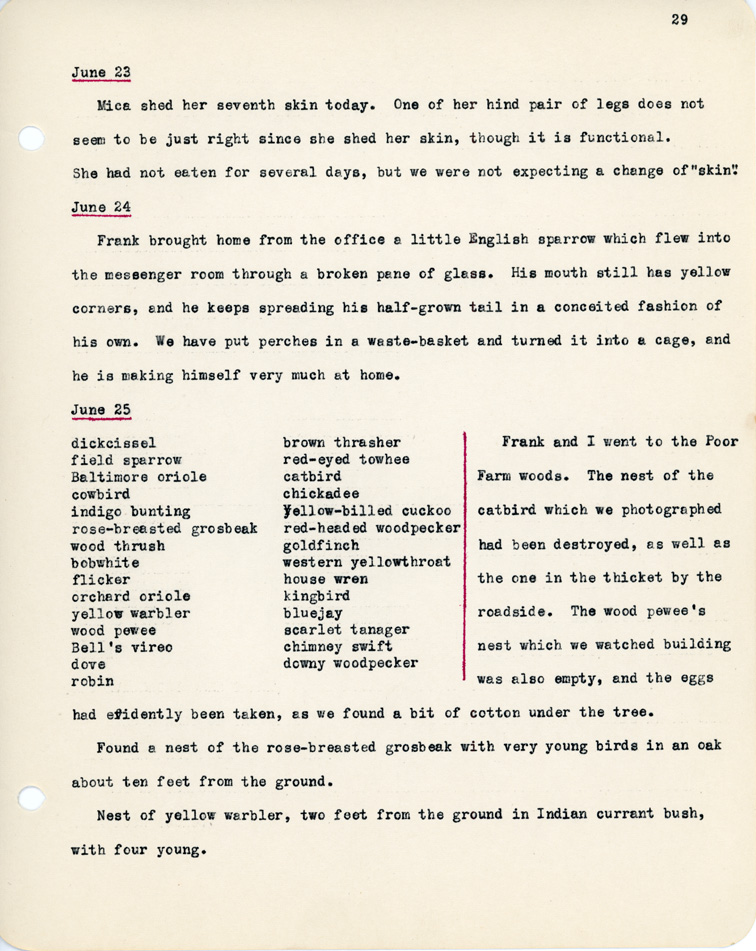
June 23
Mica shed her seventh skin today. One of her hind pair legs does not seem to be just right since she shed her skin, though it is functional. She had not eaten for several days, but we were not expecting a change of”skin”.[sic]
June 24
Frank brought home from the office a little English sparrow which flew into the messenger room through a broken pane of glass. His mouth still has yellow corners, and he keeps spreading his half-grown tail in a conceited fashion of his own. We have put perches in a waste-basket and turned it into a cage, and he is making himself very much at home.
June 25
dickcissel brown thrasher
field sparrow red-eyed towhee
Baltimore oriole catbird
cowbird chickadee
indigo bunting yellow-billed cuckoo
rose-breasted grosbeak red-headed woodpecker
wood thrush goldfinch
bobwhite western yellowthroat
flicker house wren
orchard oriole kingbird
yellow warbler bluejay
wood pewee scarlet tanager
Bell’s vireo chimney swift
dove downy woodpecker
robin
Frank and I went to the Poor Farm woods. The nest of the catbird which we photographed had been destroyed, as well as the one in the thicket by the roadside. The wood pewee’s nest which we watched building was also empty, and the eggs had efidently[sic] been taken, as we found a bit of cotton under the tree.
Found a nest of the rose-breasted grosbeak with very young birds in an oak about ten feet from the ground.
Nest of yellow warbler, two feet from the ground in Indian currant bush, with four young.
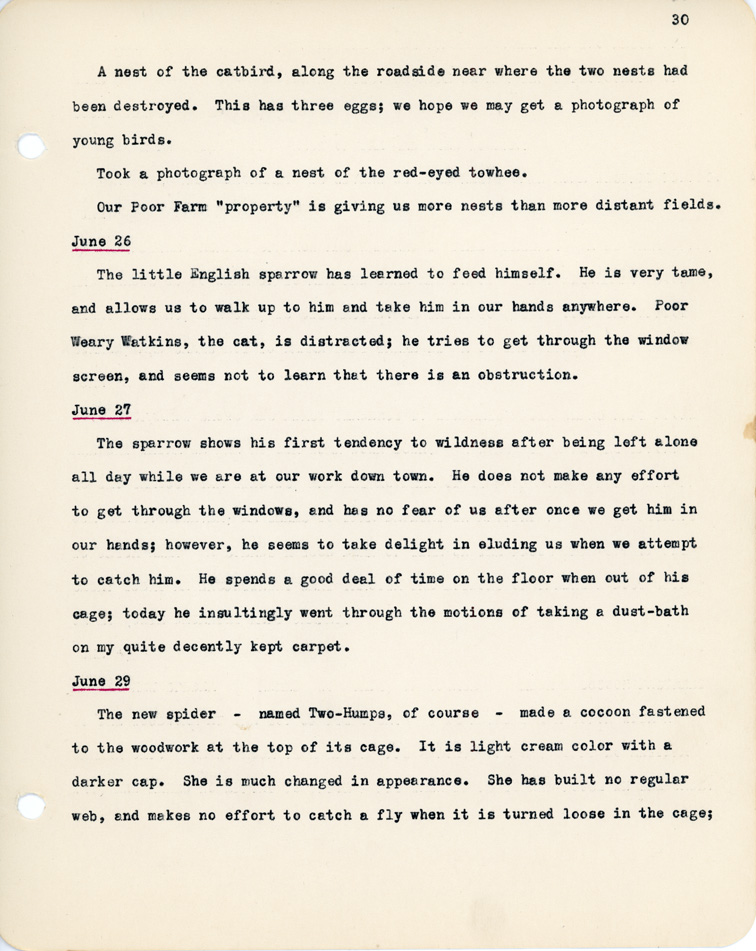
A nest of the catbird, along the roadside near where the two nests had been destroyed. This has three eggs; we hope we may get a photograph of young birds.
Took a photograph of a nest of the red-eyed towhee.
Our Poor Farm “property” is giving us more nests than more distant fields.
June 26
The little English sparrow has learned to feed himself. He is very tame, and allows us to walk up to him and take him in our hands anywhere. Poor Weary Watkings, the cat, is distracted; he tries to get through the window screen, and seems not to learn that there is an obstruction.
June 27
The sparrow shows his first tendency to wild ness after being left alone all day while we are at our work down town. He does not make any effort to get through the windows, and has no fear of us after once we get him in our hands; however, he seems to take delight in eluding us when we attempt to catch him. He spends a good deal of time on the floor when out of his cage; today he insultingly went through the motions of taking a dust-bath on my quite decently kept carpet.
June 29
The new spider – named Two-Humps, of course – made a cocoon fastened to the woodwork at the top of its cage. It is light cream color with a darker cap. She is much changed in appearance. She has built no regular web, and makes no effort to catch a fly when it is turned loose in the cage;
